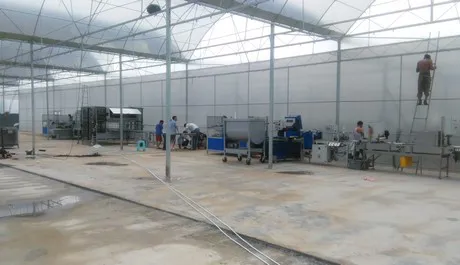Over the last few years, many hydroponic lettuce operations have been opened all over the world. The sometimes simple, but efficient cultivation method enables growers to produce large quantities of lettuce or other vegetables, in a relatively short time; all you need is a greenhouse, a pond and a decent floater that serves as a cradle for the crop. The rafts or floaters are usually made from polystyrene, a cheap material that can be formed into any desired shape. But this material has a very open structure that creates a reservoir for diseases, viruses and chemicals that cannot be effectively sterilized or cleaned once contamination occurs. This appears to be the Achilles' heel of many hydroponic growers with cultivation ponds.

The hydroponic floaters of Industrial Products Solutions in a Chinese greenhouse of 2 hectares.
In order to find a solution to this, Dutchman Andre van der Stoel of Industrial Products Solutions came up with the idea of creating a closed floater that is made from blow molded polyethylene. After several years of trialing, his system is now put into practice on a brand new 2 hectare greenhouse farm in Shanghai. He might not be the first developer that came up with the idea of a polyethylene floater, but his system is the only one so far that is totally closed, and provides no shelter to bacteria or fungus.
"What we basically did, is create a big floating bottle that can carry 69 plants," van der Stoel explained. "The floater is fully closed and has no open parts or rooms, which means that no water or diseases can enter the floaters anymore. The surface of the floaters will stay sterile and clean."

Another added benefit of the system of van der Stoel, is the size of the floater. "It is a lightweight floater, and with a length of 2,3 meters and a width of 36 centimeters, the floater can still be handled manually. This allows installation at smaller operations that wish not to use automation. As well as this, we have developed an automated lift that can handle the system, for those who like to automate the harvesting process."

Chinese investor Ben Zhu installed Industrial Products Solutions' system on a 2 hectare greenhouse operation near Shanghai.
A Chinese investor is currently the first grower to put the system into practice at a brand new project near Shanghai. "Together with a group of Dutch companies, we have been involved in this project," said van der Stoel.

The seeding and transplanting lines of Visser are used with the new floaters of Industrial Products Solutions.

Industrial Products Solutions also developed a special propagation system, compatible with the floaters.
"On a total of 2 hectares, the system will be used for the production of hydroponic lettuce, celery, spinach, and a selection of Chinese vegetables. One hectare of greenhouse will have 12 ponds and the other hectare will be used for the propagation of the young plants in a system that we have developed along. The Chinese ponds will work totally automatically, from seeding, to planting, to harvesting and planting."

Codema was responsible for the supply of water technical installations at the Chinese farm.
If you would like to obtain more information about these new aquaponic floaters,
please contact:

Industrial Products Solutions B.V.
Andre van der Stoel (e-mail)
www.industrialproductsolutions.nl
NL MOB: +31646713208
Skype: andries19711
